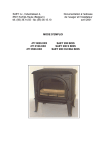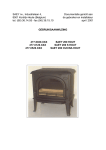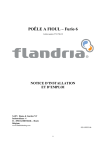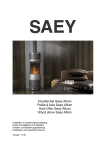Download OPERATING INSTRUCTIONS
Transcript
SAEY Home & Garden plc. Industrielaan 4 8501 Kortrijk-Heule (Belgium) tel. (056) 36.14.55 - fax (056) 36.15.10 Documentation addressed to the user and installer OPERATING INSTRUCTIONS 477.0220.000 477.0220.280 477.2520.000 477.2520.280 SAEY 200 & 200 + Anthracite SAEY 200 + Glossy dark blue SAEY 200 + CUCINA Anthracite SAEY 200 + CUCINA Glossy dark blue e-mail e-mail Dimensions Height ..................................................................................… Width ................................................................................…. Depth ....................................................................................… Diameter of the outlet duct …………………………………….. Distance from ground to bottom part of the outlet duct………… 67,5 64 52 150 45,6 cm cm cm mm cm 1. IMPORTANT WARNINGS WARNING! - The user of a stove must read the manual attentively before using the appliance for the first time. - If your stove has been installed in the living room, you must ensure a sufficient supply of fresh air in any case. - The appliance should only be used with closed doors. - When the doors remain open once the stove is functioning, the inflow of air into the stove is no longer being controlled. The danger then arises that the stove will become too hot and overheated, so that slag formation takes place and the parts exposed to the flames are damaged. The glass panel will become warped and glowing embers will burn into the glass surface. This kind of damage is not covered by the guarantee. - Shut the stove doors, even when the stove is not in operation. 2. THE CONNECTION OF A STOVE It is only when the appliance was connected by an authorised installer that you can be certain that the installation and fire protection instructions were observed. The most important connection component is the chimney. Make an appointment with a recognised chimneysweeper so that the specific regulations applicable in the country of use in this regard, are also complied with. 2 Also pay attention to the following The stove is suitable for a chimney with several shafts. For this purpose, the stove must be used with closed doors. There must be an adequate air supply. Tightly closed doors and windows may cause problems in this regard. Preferably place your stove near the chimney (hearth). A heat-resistant, fireproof base (bottom plate) must be placed underneath the stove. These bases (made of cast iron, steel sheeting…) are available commercially. In any case, ensure that the base is fireproof. Flammable objects such as doors, furniture, woodwork etc. must be at a distance of at least 60 cm. Place your appliance at least 30 cm away from the wall. The wall must consist of non-flammable material. 3. CONNECTING THE STOVE TO THE CHIMNEY The chimney draught must be above 0,08 mbar (0,8 mm WK). The diameter of the smoke duct must correspond with that of the connector (150 mm). The smoke duct must be sealed at all connection points! Attention is specifically drawn to the danger of escaping fumes. False air results in a weaker chimney draught. If the chimney draught is too strong, the installation of a draught regulator is recommended. 3.1 Saey 200 + : Top vent Normally the discharge of fumes takes place at the back. Another option is to install the smoke duct at the top. 3 Assembly of the smoke duct (optional component) for vertical fume discharge (ref. 479.0094.XXX) First you must remove the round cover plate situated in the upper plate. In order to do this, the hexagonal bolt (SW 10) that attaches the cover plate by means of the cast-iron bracket must be removed with a spanner via the smoke duct on the rear wall. The smoke duct can now be attached by means of the two hexagonal bolts (M6X20), the 4 pinions and the two hexagonal nuts (M6) provided. Finally, you must insert your hand through the opening at the top in order to reattach the round cover plate to the rear wall and screw it down by means of the cast-iron bracket and the hexagonal bolts (M6X60) that have also been provided, as well as the pinions used earlier. Take note of the following precautionary measures before the smoke duct is installed: - The diameter of the smoke duct may not be reduced and it may not be positioned horizontally, but should still rise towards the chimney at a slight angle. - The stovepipe must fit into the chimney opening to make the discharge of fumes possible. Make provision for a double lining in this regard. - Chimney connections of different stoves may not be so positioned opposite one other, i.e. at the same height. This may obstruct the discharge of exhaust fumes. The distance between two outlets for fumes should be at least 30 cm. - Do not connect too many stoves to one chimney - Too many connections hamper the upward draught. Ask your chimneysweeper for advice. - The chimney may not conduct any false air. Ensure that the chimney control valves as well as the cleaning openings in the cellar are closed. - The smoke duct must be securely attached to the connector. 3.2 Saey 200 + cucina The discharge of fumes takes place at the back. 4 4. SUITABLE FUELS The SAEY 200 + stove makes use of the following fuels: * WOOD : Logs with sticky bark, e.g. cleaved logs with a length of 45 cm. The wood should be stored for about two years, and should have a maximum residual humidity level of 20 %. Wet wood does not burn well and produces smoke, resulting in condensation and a tar discharge, which makes the stove dirty. Take care: DO NOT burn waste matter. TAKE CARE: NO coals NO synthetic fuels (e.g. FUTUREX) DO NOT burn waste matter 5. FOR THE FIRST KINDLING When used for the first time, the stove must be dried out first. For this purpose, use a little fuel to keep the fire burning for one hour. When the top air sliders are open, the glass is ‘washed’ by an air current that glides over the window. Thus, your window remains clean for a long time (= air-wash system). Fresh air is also added to the hot fumes via these openings. This causes the fumes to ignite so that a second combustion takes place, resulting in a higher output and cleaner fume emissions (= post-combustion). This causes the protective lacquer to dry up, and a smell may be given off. Monitor the combustion process carefully. In this regard, carefully wipe off any condensation drops before the residue gets a chance to burn into the enamel (e.g. the lacquer). 5 6. PRECAUTIONS A stove gets hot, especially the covering plate, the casing and the glass panel! Install your stove in a safe place in order to prevent playing children from touching it. Even if all the safety regulations are observed, there is still a risk of accidents occurring. KEEP SMALL CHILDREN AT A SAFE DISTANCE. 7. LIGHTING THE STOVE –THE STANDARD PROCEDURE When the stove is lit, open the air sliders by sliding them outwards. Open the door with the glass panel and put crumpled newspapers over the floor, with a handful of splintered wood (thin wood) on top of it. After the stove has been lit, the door with the glass panel must be firmly closed. IMPORTANT : the door with the glass panel should not be opened again, except for the purpose of topping up. 8. WOOD COMBUSTION 8.1 Topping up To stoke the fire, open the air slider to its maximum. The logs should be inserted through the door with the glass panel or the right-hand filler door and placed on the still sufficiently glowing base, in no more than two layers. Do not overfill. 6 8.2 Method The burning of wood is accompanied by high flames and heavy smoke production. Wood must be burnt up rapidly and with a constant oxygen supply. The combustion process may not be slowed down under any circumstances. Negative consequences could be: - smouldering fire, condensation and tar discharge - excessive production of soot - inconvenience caused by smoke (emission of harmful substances) - danger of asphyxiation - danger of explosion Wood provides intense combustion of short duration: Sustained combustion is only achieved through regular top-ups. This means : only when the wood has almost been burnt up and the degassing process completed - high flames are reduced to small, low flames and wood is converted into glowing embers - can the emission of heat be slowed down by closing the air slider above the door with the glass panel and the one of the ash pan. (see figure). Avoid an excessive amount of fuel in any case, otherwise the energy surge becomes too great and too much heat will be lost. 7 9. ASH REMOVAL Take note: do not poke the fire when the appliance is in operation. Wood combustion produces little ash. Because of this, the remains of the embers continue to smoulder in the glowing ash. The ash pan may be maximally filled with ash to the upper edge. No ash cone may be formed: otherwise cooling of the combustion chamber becomes impossible and the cast iron parts would begin to melt. The ash door should always be closed when the stove is in operation. If this is not done, the stove overheats and is damaged. Always remove the ash when it has cooled down. You could use an ash scoop for this purpose (not supplied). Note: Cooled ashes should nevertheless always be deposited in a fireproof container. 10. MAINTENANCE - IMPORTANT The smoke discharge duct (between the checking-plate and the rear wall) must be cleaned after every heating season – at least 1 x a year. By removing the control damper, you will be able to reach the smoke discharge duct. This makes it easy to remove the fly ash from the discharge duct as well as the connector. The control damper must be put back correctly afterwards. It is recommended that, after the heating season (i.e. during the summer months) the flue pipe between the stove and chimney should be removed or sealed in order to prevent condensation and / or corrosion in the stove. This improves the durability of your stove. 11. INSTRUCTIONS With regard to the Saey 200 + cucina, you may only place kettles, pans, etc. on the polished cooking plate after the stove has been used for a month. No water may be spilled on the hot plates, to prevent cracks from forming. When in use, the polished plate will glow and become blue. This is a normal phenomenon. The polished plate can be cleaned with steel wool or a special maintenance product intended for this purpose. 8 12. GUARANTEE THE MANUFACTURER GUARANTEES a. b. impeccable quality and processing of the raw materials according to the stated requirements assembled by an expert The guarantees a. and b. provide for free replacement to the appliance to parts declared unfit for use. Such parts are only replaced free of charge when it can be proven that there are flaws in the raw materials or in the workmanship. No further claims may be made. THE MANUFACTURER DOES NOT GUARANTEE Parts that are subject to wear and tear, and damage to and defects in the appliances or their parts, caused by: transport, storage, incorrect installation and use of appliance (e.g. overheating). Use of inferior fuels – incorrect operation. The manufacturer is not responsible for direct or indirect damage caused by the appliance. No claim can be laid to a full or partial exchange, unless the manufacturer is unable to fix the flaw or damage within a certain time span. 9 Maximum stacking height of logs Detail cucina upper plate (Saey 200 + cucina ) Secondary air conditioning inside : outside : closed open 040123 10



















